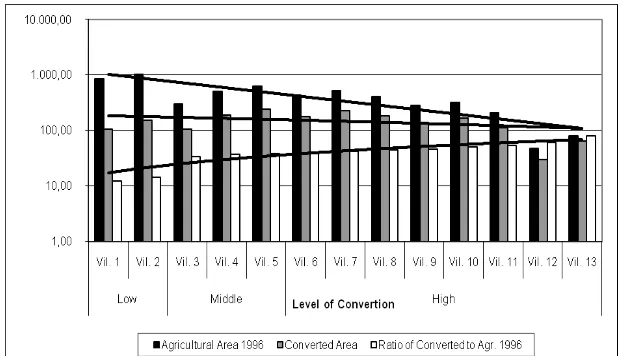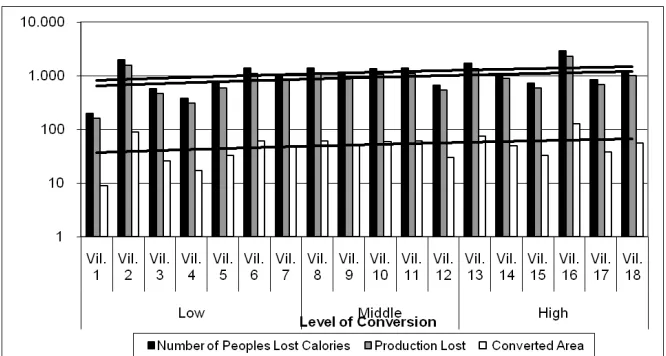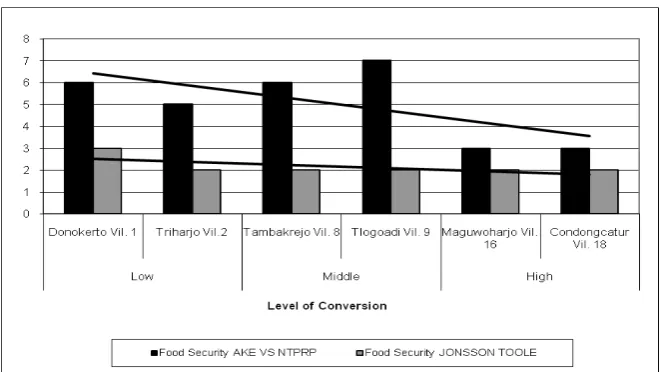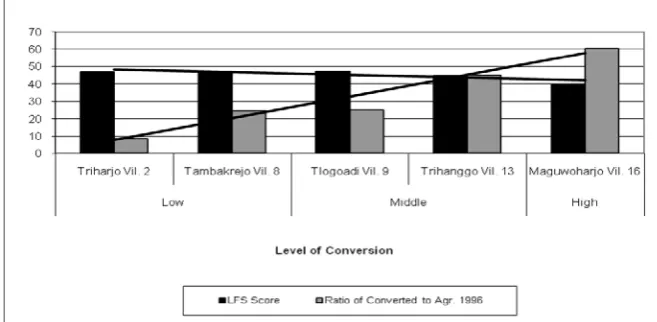Urban Sprawl, Farming Prospects and Sustainability of
Yogyakarta City, Indonesia
Irham
Graduate Program in Agribusiness, Gadjah Mada University
Abstract
The objectives of the study are: (1) to analyze the impact of urban sprawl on farmland conversion by using landsat data, (2) to analyze the impact of land conversion on food supply and food security, (3) to understand the prospect of farming activities in the fringe area of Yogyakarta, and (4) to find implication of urban sprawl towards sustainability of Yogyakarta city. The study shows that urban development in Yogyakarta is seen to be conflicting rather than compromising process that threatens the sustainability of the city. It is found that the most noticeable urban sprawl is the conversion of farmland to residential uses causing food insecurity within the area, and the prospect of farming activities become uncertain.
Introduction
The fusion between urban and rural areas not only has become a main is-sue in urban planning but it has also been a central theme of sustainable city. Such a “new” paradigm is promoted due to the fact that the intensive urban and rural interactions in any forms such as physical, social and eco-nomic are expected to be key factors in contributing towards sustainable urban development.
concept of urban-rural fusion by integrating urban and rural areas becomes a promising approach in urban development. Even in a rather broad sense, municipalities could be regarded as cities integrating everything from up-stream forests to mid-up-stream farmland and villages to downup-stream urban-ized areas, even down to the coast (Takeuchi at al., 2009). This is in con-trast to what has been really taking place in urban planning by making a sharp distinction between urban and rural areas.
Whatever the concept of urban-rural fusion for sustainable city is used, the role of farmland in supporting the city live is worth noting. Hence, ef-fective land use planning and policy in controlling farmland encroachment surrounding the city becomes justified. In the case of Yogyakarta city, such strict control is strongly needed for many reasons (Irham, 2009): (1) most of new development of urban uses take place in areas of agricultural land; (2) farmland is a precious resource where most of people activities are engaged; (3) the farmland is very fertile since it comprises volcanic soils; (4) self-sufficiency in food production depends on sufficient availability of farmland; and (5) loss of farmland is usually ir-reversible.
The serious impacts of uncontrolled farmland conversion in sub-urban area of Yogyakarta are: (1) decrease of farming activities prospect sur-rounding the city area that leads to less farm sustainability, (2) the loss of fertile farm land, threatening food security within the area, and (3) sustain-ability of city lives becomes disturbed as many people loss their opportu-nity to get food supplied by the city itself. Consequently, the city dwellers become more and more dependent of food from outside supply.
Many studies show that urban and sub-urban agriculture often provides a significant contribution to many major cities’ food self-reliance (Soni and Salokhe, 2009). The intensive farmland conversion surrounding the city of Yogyakarta has lowered the potentiality of sub-urban and urban ag-riculture that contribute to cities food supply. Therefore, preservation of agricultural land becomes a key factor of sustainable city development as urban people highly dependant on the availability of farm production.
The importance of such initiative is essentially based on two considera-tions. First, the growing recognition of farmland as important aesthetic and environmental attributes (Irham, 1998). Second, the need to protect the nation's long term food producing capabilities because without an ade-quate protection of agricultural land resources, the country will find dif-ficulty to meet the food needs for growing population especially in the city regions (Irham and Sudirman, 2009).
under-stand the prospect of farming activities in the fringe area of Yogyakarta, and (4) to find implication of urban sprawl towards sustainability of Yogyakarta city.
Experimental – Method
The study was conducted in fringe areas of Yogyakarta city. The study area covers part of three adjacent districts, namely Sleman district (favourable farming), Bantul district (favourable) and Kulonprogo district (less favourable). Fourty seven villages within those three districts are se-lected as study area samples. Eighteen villages are in Sleman (northern part of the city, thirteen villages in Bantul (southern part), and sixteen vil-lages are in Kulonprogo (western part).
Landsat data of 1996 and 2007 is used to analyse the dynamics of land conversion taken place in all villages of the study area. The area of con-verted farmland is obtained by overlaying those two sequential year od the landsat data. From the selected villages, 201 farmers (50 farmers in Sle-man, 48 farmers in Bantul and 103 farmers in Kulonprogo) in were inter-viewed to get information on their views regarding food security and pros-pect of farming activities.
Production loss is calculated from potential rice production of con-verted area in each village (in kg). The rice production is then concon-verted to calories to get the forgone calories or number of people who lost possibil-ity to consume the available calories in the study area. Prospect of farming activities is analyzed from the view of land-holding farmers about their farmland during the last five years and coming five. The farmers’ view is obtained by giving them 9 questions about the existing condition of farm-land during the last five years and 11 questions about their expectation within coming five years whether they will stay in farm or not.
Results and discussion
One of the impacts of urban sprawl is conversion of farmland to other uses such as industry, housing, roads, offices, etc. Since Yogyakarta is not a typical of industrial city, the most distinctive conversion in the fringe area of Yogyakarta city is from farmland to housing. Massive development of housing complex taking place during the last twenty years becomes the main cause of such high conversion rate.
In the area of Sleman district (most favorable region), 922 ha of fertile farmland has been converted mostly to housing complex, with the rate of conversion about 33% during the last ten years (1.1% annually). In Bantul district (favorable region), the converted area during the last ten years was nearly 1900 ha with conversion rate 4,3% annually. Although Sleman is the most favorable region, but the conversion rate is less than that of Ban-tul since the fastest conversion process in Sleman took place 1990s.
Although Kulonprogo district is less favorable region, but it shows an almost similar trend with Bantul. The converted area of farmland is counted to 1,085 ha during the last ten years. The conversion rate is just 1.7 % every year. Similar to Bantul district, the massive conversion has been taking place during the last ten years. There is a strong relation the rate of conversion and the closeness to the city center reflected in low, middle and high conversion rate (Figure 1).
Land conversion and Production Loss
The direct impact of farmland conversion is towards production loss in terms of rice (as main staple food) lost every year. The result of analysis shows that almost 20 ton of rice was lost in the study area due to conver-sion (4.6 ton in Sleman, and 9.4 ton and 5.4 ton in Bantul and Kulonprogo, respectively). If the amount of rice is converted into calories, and then converting into equivalent-people, it is found that more than 25 thousand people lost their opportunity to get food in Sleman, 42.3 thousand people in Bantul, and 48.5 thousand people in Kulonprogo (Figure 2).
The analysis shows that the loss of calories and the number of people who lost the opportunity to get food due to conversion are increased as the rate of conversion is increased, except in Bantul. The conversion rate and production lost tend to decrease because of two reasons: (1) the success of local government in increasing rice yield, and (2) a successful effort of the local government in promoting food diversification
Fig. 2. Land conver sion and food calor ie loss
Food Supply and Food Security
equivalent to 69.4 thousand people. While in kulonprogo district, it is es-timated to be 42.7 million calories equivalent to 52.2 thousand people.
The availability of food (food supply) will determine food security of certain region. By using Jonsson and Toole method, it is found that the higher the conversion rate, the lower the food security in Sleman district. This tendency is consistent with that of by using modified method but showing more significant trend. A rather similar trend is found in Kulon-progo district. The higher the conversion rate, the lower the food security, although the trend shows less significant (Figure 3).
From Figure 3 it can be seen that Bantul district has a different pheno-menon. The higher the conversion rate, the higher the food security. Such a trend is showed either by Jonsson and Toole method or by the modified one. This is due to the fact that the people in the high rate conversion area change their work from farming to non-farm activities especially for young people.
Fig. 3. Land conver sion and food secur ity.
Prospect of Farming Activities
By using LFS (level of sustainability score), it is found that the higher the rate of conversion, the less prospective of the farming activities in Sleman distrct. From the farmers’ view, such tendency is mainly caused by their plan in the coming years rather than by the existing condition during the last five years.
Bantul district shows a similar tendency like Sleman. The higher the conversion rate, the lower the sustainability of farming. The main cause is due to the plan of farmers on their land for the years ahead. This is differ-ent from that of Kulonprogo district. Although it has a similar trend in LFS score, but the main reason for the lower sustainability is mainly because of the condition during the last five years.
Fig. 4. Land conver sion and far ming pr ospect.
Implication on Sustainability of Yogyakarta City
fixed farmland area in each district in order to secure food sufficiency sup-ported by strict zoning ordinance.
Conclusions and Recommendations
1. As favourable region, Bantul district has the highest annual farmland conversion rate (4.3%) compared to that of Kulonprogo district (1.7%) and Sleman district (1.1%).
2. The analysis shows that the loss of calories and the number of people who lost the opportunity to get food due to conversion are increased as the rate of conversion is increased, except in Bantul. The conversion rate and production lost tend to decrease because of two reasons: (1) the success of local government in increasing rice yield, and (2) a success-ful effort of the local government in promoting food diversification. 3. The analysis shows that the loss of calories and the number of people
who lost the opportunity to get food due to conversion are increased as the rate of conversion is increased, except in Bantul.
4. The study found that the higher the conversion rate, the lower the food security both in Sleman and Kulonprogo district, except in Bantul dis-trict.
5. By using LFS (level of sustainability score), it is found that the higher the rate of conversion, the less prospective of the farming activities in the three study areas (Sleman, Bantul dan Kulonprogo districts).
6. Having that farmland conversion has caused production loss, food inse-curity and unsustainable farming activities that affect the sustainability of the city of Yogyakarta, the protection of farmland should be part of the development of the city in order to be sustainable. This is in line with the fusion concept between urban dan rural activities.
References
1. Clawson M (1971) Suburban Land Conversion in the United States: An Economic and Governmental Process. The John Hopkins Press, Balti-more and London.
2. Conklin HE, Bryant WR (1974). Agricultural Districts: A Compromise Ap-proach to Farmland Preservation. American Journal of Agricultural Econom-ics, Vol.56, No.3, pp. 607-613.
3. Furuseth OJ (1982) Agricultural Land Conversion: Background and Issues. Journal of Geography, Vol 81, No.3, pp. 89-93.
4. Irham (2009) Farmland Conversion and Sustainable City. Proceeding of In-ternational Workshop on Sustainable City Region. Bali, Indonesia.
5. Isberg G (1975) Controlling Growth in Urban Fringe in Scott W (ed) Man-agement and Control of Growth: Issues, Techniques, Problems, Trends. The Urban Land Institute, Washington D.C.
6. Lapping MB (1975) Preserving Agricultural Lands: The New York Experi-ence. Town and Country Planning, pp. 394-397.
7. Lockeretz W, Freedgood J, Coon K (1987) Farmers’ View of the Prospects for Agriculture in a Metropolitan Area. Agricultural Systems 23, 43-61. 8. Pacino M (1990) Development Pressure in the Metropolitan Fringe. Land
Development Studies, Vol.7, No.2, pp.69-82.
9. Soni P (2009) Strategic Analysis of Urban/Peri-Urban Agriculture in Asia: Issues, Potential and Challenges. Proceeding of International Workshop on Sustainable City Region. Bali, Indonesia.



